Exploring Transnational Indian Drama in the Context of Asian Cinema
VerifiedAdded on 2020/05/16
|6
|1342
|136
Essay
AI Summary
This essay delves into the concept of transnational Indian drama within the context of Asian cinema, exploring how globalization has influenced the economic and cultural aspects of Indian films. It examines the emergence of Bollywood and its evolution, highlighting films like 'My Name is Khan' and 'Bride and Prejudice' as examples of how Indian cinema incorporates diverse cultures and reflects the transnational movement. The essay discusses the historical background of Indian cinema, from its inception with Dadasaheb Phalke to its current status, emphasizing the role of cultural diversity and ethnicity in filmmaking. It also analyses how drama, a key element of Indian cinema, is used to blend traditional Hollywood settings with Bollywood's unique style, showcasing the increasing trend of transnational themes in Indian films and the integration of various cultures, including those of the US and UK.
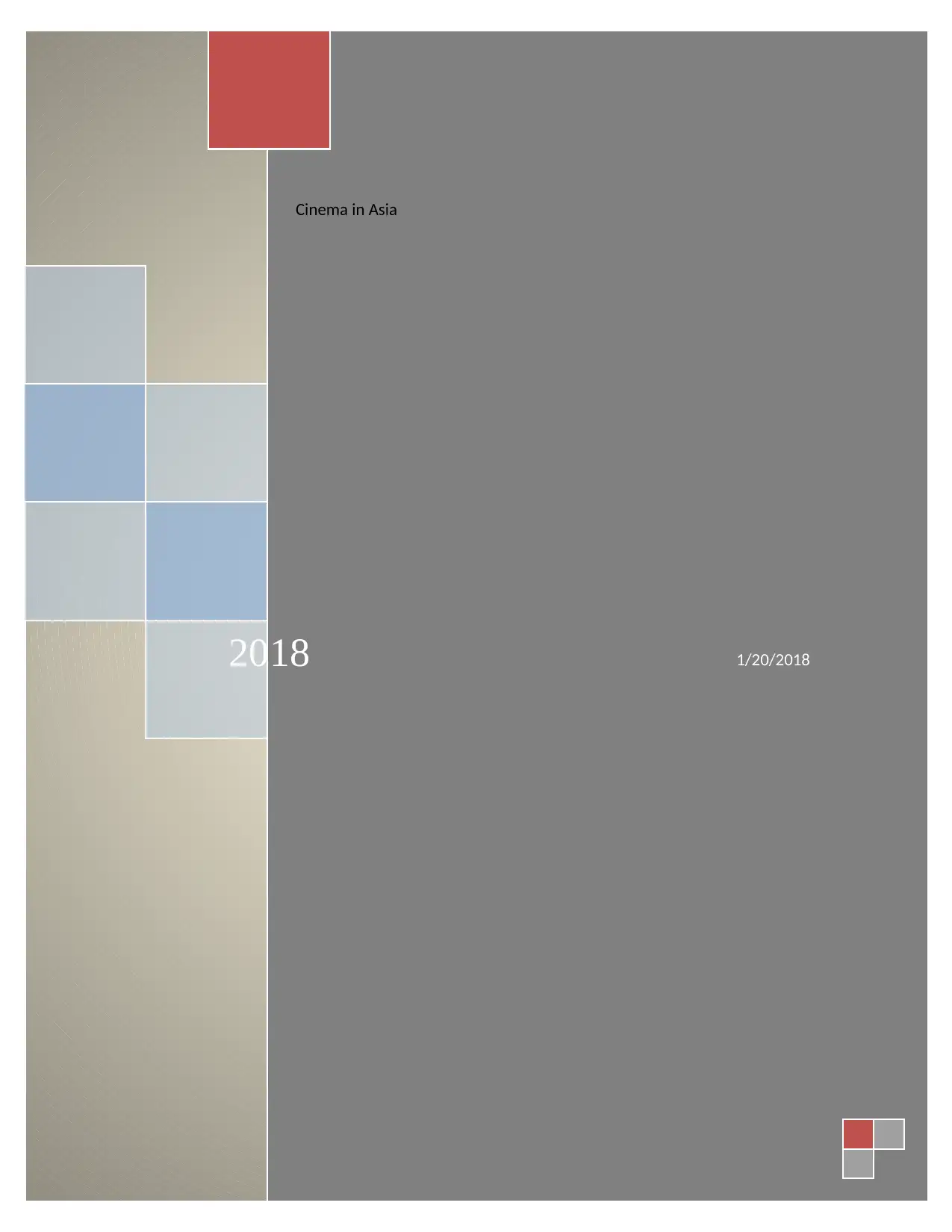
1/20/20182018
Cinema in Asia
Cinema in Asia
Secure Best Marks with AI Grader
Need help grading? Try our AI Grader for instant feedback on your assignments.
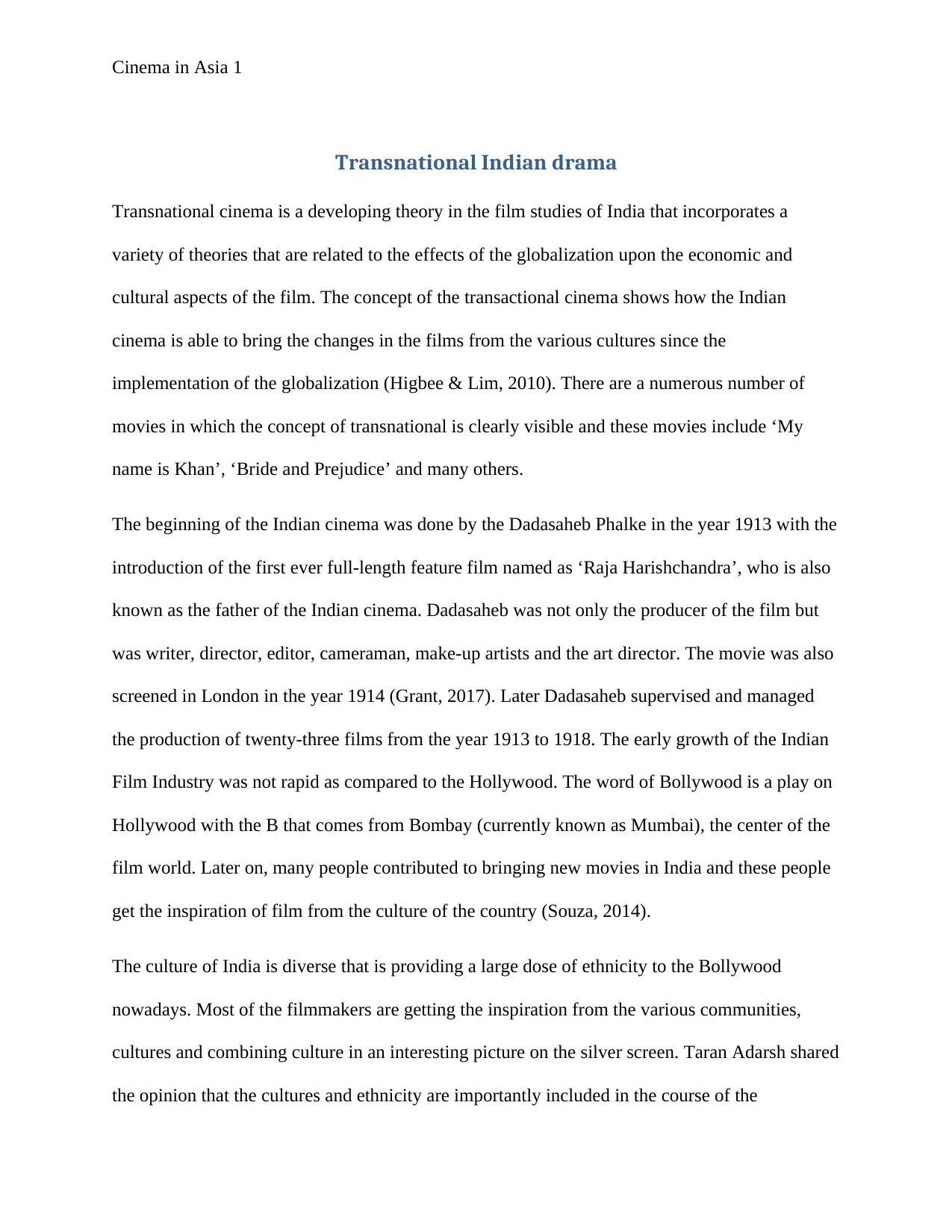
Cinema in Asia 1
Transnational Indian drama
Transnational cinema is a developing theory in the film studies of India that incorporates a
variety of theories that are related to the effects of the globalization upon the economic and
cultural aspects of the film. The concept of the transactional cinema shows how the Indian
cinema is able to bring the changes in the films from the various cultures since the
implementation of the globalization (Higbee & Lim, 2010). There are a numerous number of
movies in which the concept of transnational is clearly visible and these movies include ‘My
name is Khan’, ‘Bride and Prejudice’ and many others.
The beginning of the Indian cinema was done by the Dadasaheb Phalke in the year 1913 with the
introduction of the first ever full-length feature film named as ‘Raja Harishchandra’, who is also
known as the father of the Indian cinema. Dadasaheb was not only the producer of the film but
was writer, director, editor, cameraman, make-up artists and the art director. The movie was also
screened in London in the year 1914 (Grant, 2017). Later Dadasaheb supervised and managed
the production of twenty-three films from the year 1913 to 1918. The early growth of the Indian
Film Industry was not rapid as compared to the Hollywood. The word of Bollywood is a play on
Hollywood with the B that comes from Bombay (currently known as Mumbai), the center of the
film world. Later on, many people contributed to bringing new movies in India and these people
get the inspiration of film from the culture of the country (Souza, 2014).
The culture of India is diverse that is providing a large dose of ethnicity to the Bollywood
nowadays. Most of the filmmakers are getting the inspiration from the various communities,
cultures and combining culture in an interesting picture on the silver screen. Taran Adarsh shared
the opinion that the cultures and ethnicity are importantly included in the course of the
Transnational Indian drama
Transnational cinema is a developing theory in the film studies of India that incorporates a
variety of theories that are related to the effects of the globalization upon the economic and
cultural aspects of the film. The concept of the transactional cinema shows how the Indian
cinema is able to bring the changes in the films from the various cultures since the
implementation of the globalization (Higbee & Lim, 2010). There are a numerous number of
movies in which the concept of transnational is clearly visible and these movies include ‘My
name is Khan’, ‘Bride and Prejudice’ and many others.
The beginning of the Indian cinema was done by the Dadasaheb Phalke in the year 1913 with the
introduction of the first ever full-length feature film named as ‘Raja Harishchandra’, who is also
known as the father of the Indian cinema. Dadasaheb was not only the producer of the film but
was writer, director, editor, cameraman, make-up artists and the art director. The movie was also
screened in London in the year 1914 (Grant, 2017). Later Dadasaheb supervised and managed
the production of twenty-three films from the year 1913 to 1918. The early growth of the Indian
Film Industry was not rapid as compared to the Hollywood. The word of Bollywood is a play on
Hollywood with the B that comes from Bombay (currently known as Mumbai), the center of the
film world. Later on, many people contributed to bringing new movies in India and these people
get the inspiration of film from the culture of the country (Souza, 2014).
The culture of India is diverse that is providing a large dose of ethnicity to the Bollywood
nowadays. Most of the filmmakers are getting the inspiration from the various communities,
cultures and combining culture in an interesting picture on the silver screen. Taran Adarsh shared
the opinion that the cultures and ethnicity are importantly included in the course of the
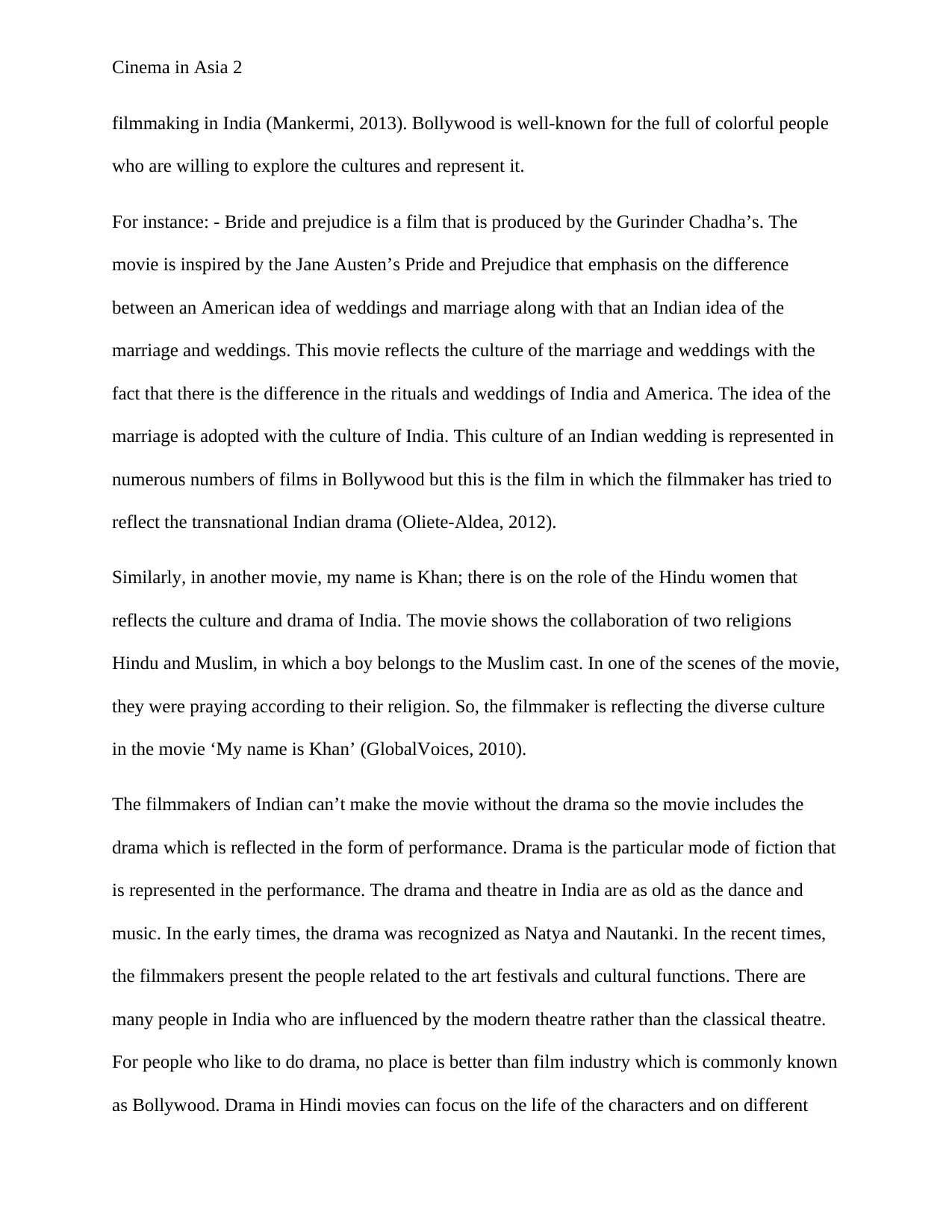
Cinema in Asia 2
filmmaking in India (Mankermi, 2013). Bollywood is well-known for the full of colorful people
who are willing to explore the cultures and represent it.
For instance: - Bride and prejudice is a film that is produced by the Gurinder Chadha’s. The
movie is inspired by the Jane Austen’s Pride and Prejudice that emphasis on the difference
between an American idea of weddings and marriage along with that an Indian idea of the
marriage and weddings. This movie reflects the culture of the marriage and weddings with the
fact that there is the difference in the rituals and weddings of India and America. The idea of the
marriage is adopted with the culture of India. This culture of an Indian wedding is represented in
numerous numbers of films in Bollywood but this is the film in which the filmmaker has tried to
reflect the transnational Indian drama (Oliete-Aldea, 2012).
Similarly, in another movie, my name is Khan; there is on the role of the Hindu women that
reflects the culture and drama of India. The movie shows the collaboration of two religions
Hindu and Muslim, in which a boy belongs to the Muslim cast. In one of the scenes of the movie,
they were praying according to their religion. So, the filmmaker is reflecting the diverse culture
in the movie ‘My name is Khan’ (GlobalVoices, 2010).
The filmmakers of Indian can’t make the movie without the drama so the movie includes the
drama which is reflected in the form of performance. Drama is the particular mode of fiction that
is represented in the performance. The drama and theatre in India are as old as the dance and
music. In the early times, the drama was recognized as Natya and Nautanki. In the recent times,
the filmmakers present the people related to the art festivals and cultural functions. There are
many people in India who are influenced by the modern theatre rather than the classical theatre.
For people who like to do drama, no place is better than film industry which is commonly known
as Bollywood. Drama in Hindi movies can focus on the life of the characters and on different
filmmaking in India (Mankermi, 2013). Bollywood is well-known for the full of colorful people
who are willing to explore the cultures and represent it.
For instance: - Bride and prejudice is a film that is produced by the Gurinder Chadha’s. The
movie is inspired by the Jane Austen’s Pride and Prejudice that emphasis on the difference
between an American idea of weddings and marriage along with that an Indian idea of the
marriage and weddings. This movie reflects the culture of the marriage and weddings with the
fact that there is the difference in the rituals and weddings of India and America. The idea of the
marriage is adopted with the culture of India. This culture of an Indian wedding is represented in
numerous numbers of films in Bollywood but this is the film in which the filmmaker has tried to
reflect the transnational Indian drama (Oliete-Aldea, 2012).
Similarly, in another movie, my name is Khan; there is on the role of the Hindu women that
reflects the culture and drama of India. The movie shows the collaboration of two religions
Hindu and Muslim, in which a boy belongs to the Muslim cast. In one of the scenes of the movie,
they were praying according to their religion. So, the filmmaker is reflecting the diverse culture
in the movie ‘My name is Khan’ (GlobalVoices, 2010).
The filmmakers of Indian can’t make the movie without the drama so the movie includes the
drama which is reflected in the form of performance. Drama is the particular mode of fiction that
is represented in the performance. The drama and theatre in India are as old as the dance and
music. In the early times, the drama was recognized as Natya and Nautanki. In the recent times,
the filmmakers present the people related to the art festivals and cultural functions. There are
many people in India who are influenced by the modern theatre rather than the classical theatre.
For people who like to do drama, no place is better than film industry which is commonly known
as Bollywood. Drama in Hindi movies can focus on the life of the characters and on different
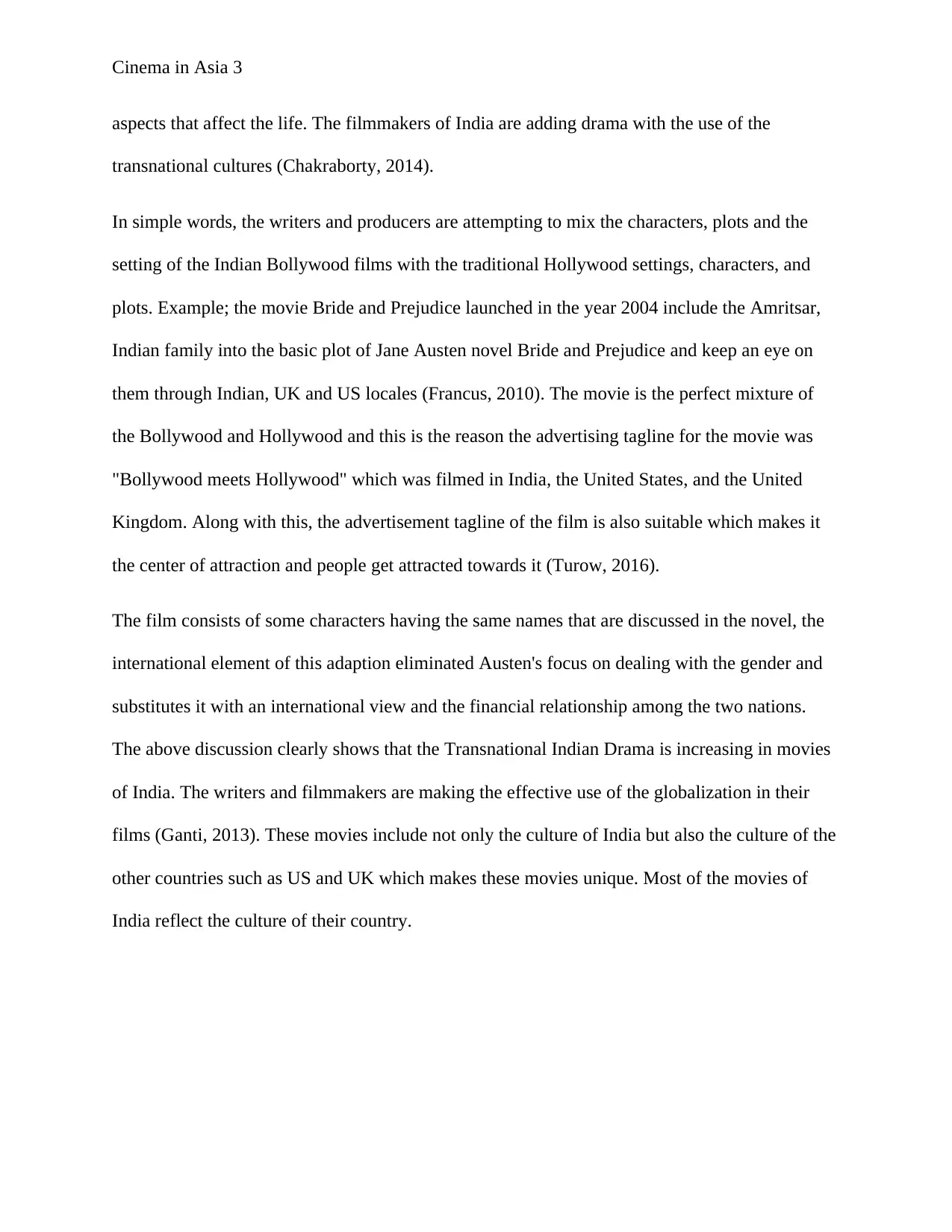
Cinema in Asia 3
aspects that affect the life. The filmmakers of India are adding drama with the use of the
transnational cultures (Chakraborty, 2014).
In simple words, the writers and producers are attempting to mix the characters, plots and the
setting of the Indian Bollywood films with the traditional Hollywood settings, characters, and
plots. Example; the movie Bride and Prejudice launched in the year 2004 include the Amritsar,
Indian family into the basic plot of Jane Austen novel Bride and Prejudice and keep an eye on
them through Indian, UK and US locales (Francus, 2010). The movie is the perfect mixture of
the Bollywood and Hollywood and this is the reason the advertising tagline for the movie was
"Bollywood meets Hollywood" which was filmed in India, the United States, and the United
Kingdom. Along with this, the advertisement tagline of the film is also suitable which makes it
the center of attraction and people get attracted towards it (Turow, 2016).
The film consists of some characters having the same names that are discussed in the novel, the
international element of this adaption eliminated Austen's focus on dealing with the gender and
substitutes it with an international view and the financial relationship among the two nations.
The above discussion clearly shows that the Transnational Indian Drama is increasing in movies
of India. The writers and filmmakers are making the effective use of the globalization in their
films (Ganti, 2013). These movies include not only the culture of India but also the culture of the
other countries such as US and UK which makes these movies unique. Most of the movies of
India reflect the culture of their country.
aspects that affect the life. The filmmakers of India are adding drama with the use of the
transnational cultures (Chakraborty, 2014).
In simple words, the writers and producers are attempting to mix the characters, plots and the
setting of the Indian Bollywood films with the traditional Hollywood settings, characters, and
plots. Example; the movie Bride and Prejudice launched in the year 2004 include the Amritsar,
Indian family into the basic plot of Jane Austen novel Bride and Prejudice and keep an eye on
them through Indian, UK and US locales (Francus, 2010). The movie is the perfect mixture of
the Bollywood and Hollywood and this is the reason the advertising tagline for the movie was
"Bollywood meets Hollywood" which was filmed in India, the United States, and the United
Kingdom. Along with this, the advertisement tagline of the film is also suitable which makes it
the center of attraction and people get attracted towards it (Turow, 2016).
The film consists of some characters having the same names that are discussed in the novel, the
international element of this adaption eliminated Austen's focus on dealing with the gender and
substitutes it with an international view and the financial relationship among the two nations.
The above discussion clearly shows that the Transnational Indian Drama is increasing in movies
of India. The writers and filmmakers are making the effective use of the globalization in their
films (Ganti, 2013). These movies include not only the culture of India but also the culture of the
other countries such as US and UK which makes these movies unique. Most of the movies of
India reflect the culture of their country.
Secure Best Marks with AI Grader
Need help grading? Try our AI Grader for instant feedback on your assignments.
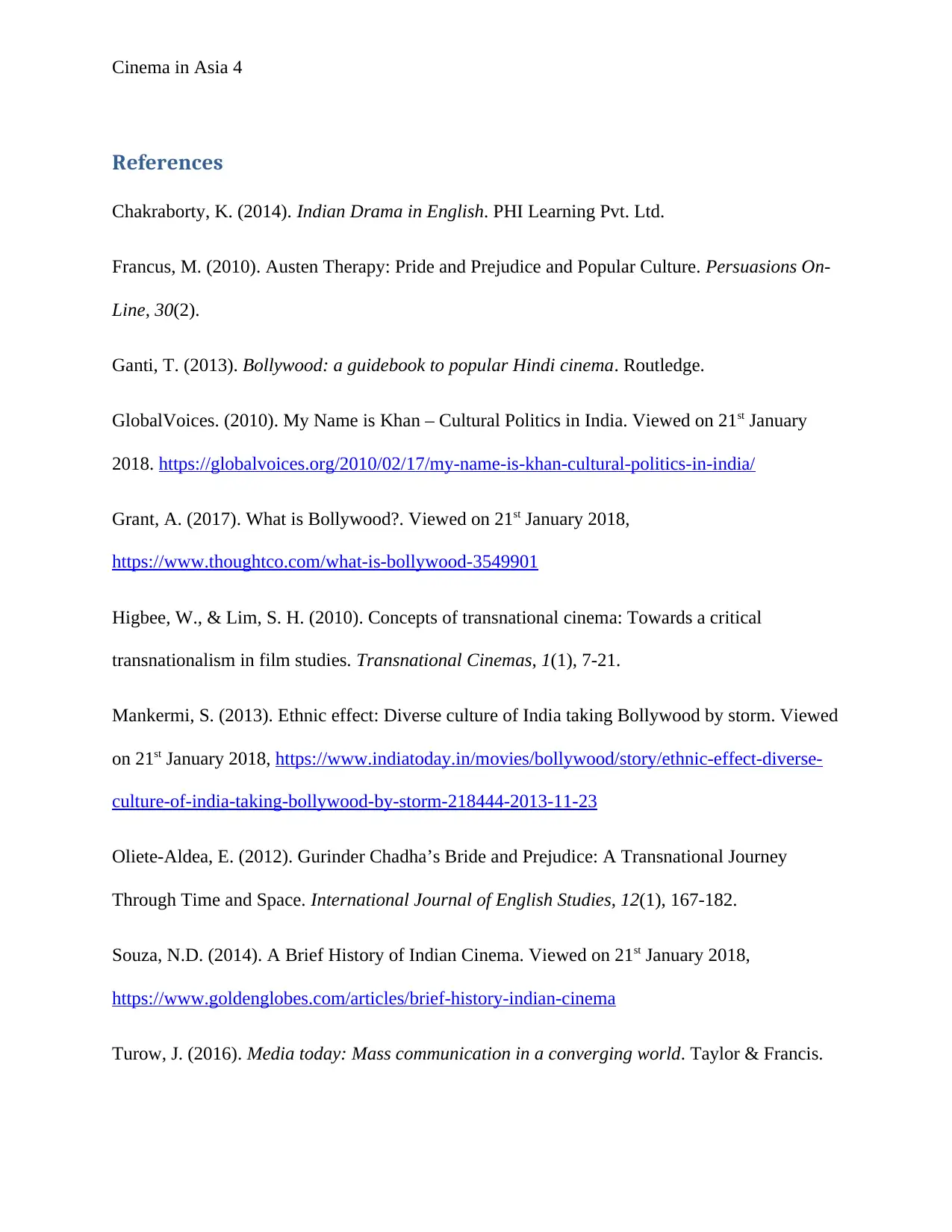
Cinema in Asia 4
References
Chakraborty, K. (2014). Indian Drama in English. PHI Learning Pvt. Ltd.
Francus, M. (2010). Austen Therapy: Pride and Prejudice and Popular Culture. Persuasions On-
Line, 30(2).
Ganti, T. (2013). Bollywood: a guidebook to popular Hindi cinema. Routledge.
GlobalVoices. (2010). My Name is Khan – Cultural Politics in India. Viewed on 21st January
2018. https://globalvoices.org/2010/02/17/my-name-is-khan-cultural-politics-in-india/
Grant, A. (2017). What is Bollywood?. Viewed on 21st January 2018,
https://www.thoughtco.com/what-is-bollywood-3549901
Higbee, W., & Lim, S. H. (2010). Concepts of transnational cinema: Towards a critical
transnationalism in film studies. Transnational Cinemas, 1(1), 7-21.
Mankermi, S. (2013). Ethnic effect: Diverse culture of India taking Bollywood by storm. Viewed
on 21st January 2018, https://www.indiatoday.in/movies/bollywood/story/ethnic-effect-diverse-
culture-of-india-taking-bollywood-by-storm-218444-2013-11-23
Oliete-Aldea, E. (2012). Gurinder Chadha’s Bride and Prejudice: A Transnational Journey
Through Time and Space. International Journal of English Studies, 12(1), 167-182.
Souza, N.D. (2014). A Brief History of Indian Cinema. Viewed on 21st January 2018,
https://www.goldenglobes.com/articles/brief-history-indian-cinema
Turow, J. (2016). Media today: Mass communication in a converging world. Taylor & Francis.
References
Chakraborty, K. (2014). Indian Drama in English. PHI Learning Pvt. Ltd.
Francus, M. (2010). Austen Therapy: Pride and Prejudice and Popular Culture. Persuasions On-
Line, 30(2).
Ganti, T. (2013). Bollywood: a guidebook to popular Hindi cinema. Routledge.
GlobalVoices. (2010). My Name is Khan – Cultural Politics in India. Viewed on 21st January
2018. https://globalvoices.org/2010/02/17/my-name-is-khan-cultural-politics-in-india/
Grant, A. (2017). What is Bollywood?. Viewed on 21st January 2018,
https://www.thoughtco.com/what-is-bollywood-3549901
Higbee, W., & Lim, S. H. (2010). Concepts of transnational cinema: Towards a critical
transnationalism in film studies. Transnational Cinemas, 1(1), 7-21.
Mankermi, S. (2013). Ethnic effect: Diverse culture of India taking Bollywood by storm. Viewed
on 21st January 2018, https://www.indiatoday.in/movies/bollywood/story/ethnic-effect-diverse-
culture-of-india-taking-bollywood-by-storm-218444-2013-11-23
Oliete-Aldea, E. (2012). Gurinder Chadha’s Bride and Prejudice: A Transnational Journey
Through Time and Space. International Journal of English Studies, 12(1), 167-182.
Souza, N.D. (2014). A Brief History of Indian Cinema. Viewed on 21st January 2018,
https://www.goldenglobes.com/articles/brief-history-indian-cinema
Turow, J. (2016). Media today: Mass communication in a converging world. Taylor & Francis.

Cinema in Asia 5
1 out of 6
Your All-in-One AI-Powered Toolkit for Academic Success.
+13062052269
info@desklib.com
Available 24*7 on WhatsApp / Email
![[object Object]](/_next/static/media/star-bottom.7253800d.svg)
Unlock your academic potential
© 2024 | Zucol Services PVT LTD | All rights reserved.
